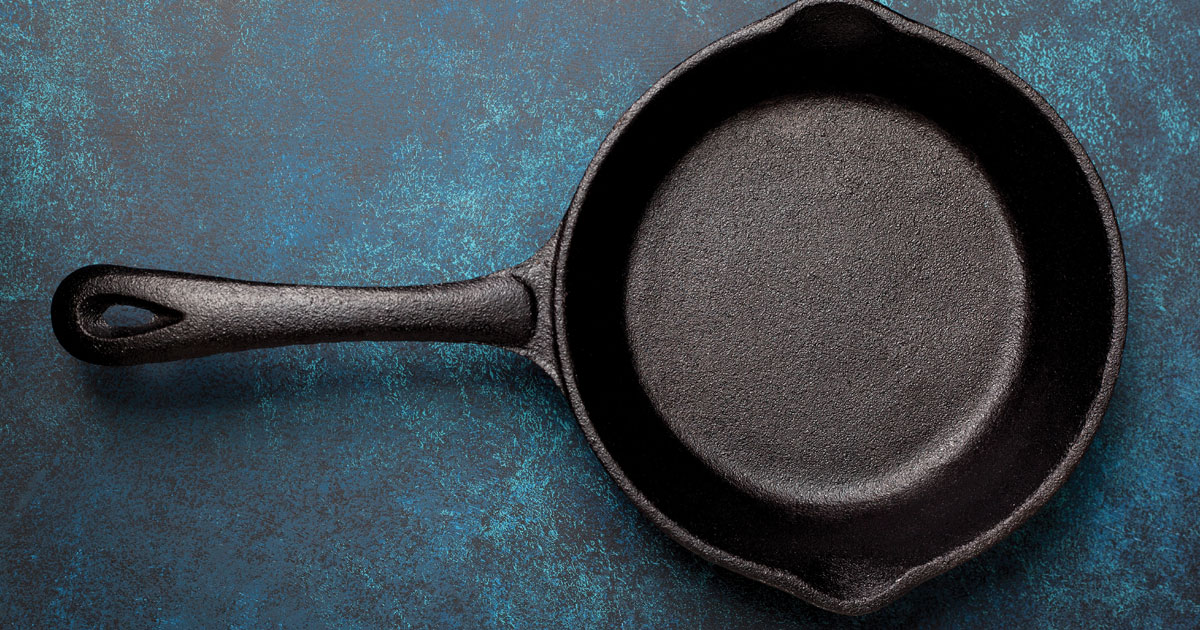Ruggedly handsome! Strong!
It may sound odd for an individual to describe an item of cookware in such loving terms; however, I am not alone. Generations of families have considered the cast-iron pan, kettle, or skillet a staple of their households. Versatility allows it to go beyond the range top and oven into a campfire or fireplace; therefore, owners do not worry about using it in high temperatures. It only needs care, frequent seasoning, and abiding by the requirements of proper storage.
Eliminating the Negatives
In addition to the weight of the pan, a second concern is a fear cast-iron will transfer deposits of iron directly onto the food. Uncertain of the truth, many believed it was better to be safe than sorry.
Constructed from natural materials, cast-iron it is not made in a laboratory or from chemicals. In removing contaminants, the remaining liquid is poured into a mold. Damage will not occur if it is dropped or scratched. The only means to end its purpose is through the threat of soap, and discontinued care, which will result in rust. Yes, cast-iron can be dangerous if not adequately cleaned and seasoned, or if the owner abandons its rules. One solution to ensure you do not miss out on one of the most durable and everlasting types of cookware is to invest in a cast-iron pan with enamel coating.
A Pan with Rules
Unlike stainless steel, porcelain, Calphalon, Teflon, and glass, cast-iron will endure time. Initially, it can be a high maintenance relationship.
- Washing: It is a mindset to believe soap and water is the only combination to wash away grease and dirt. For a pan transformed through the process of seasoning, soap will strip away and alter its surface. Cast-iron has simple, yet specific requirements. After the pan has reached a temperature of warmth, take it to the sink and scrub with chainmail or a stiff brush while water is running. Immediately dry thoroughly by placing the pan on a burner for two minutes.
- A Light Seasoning: Before storing, drop a half teaspoon of oil inside the warm pan. With a paper towel, run a thin coat around the base and sides. Use another paper towel to remove the excess.
- Seasoning: Whether the pan is new, old, or frequently used, a cast-iron pan should never be considered hopeless. To rejuvenate or merely to maintain its longevity, the process of seasoning is essential. With a thin layer of vegetable oil coated over the entire surface of the pan, place it upside down in the oven at a temperature of 350-degrees for an hour. (It is wise to put a large cookie sheet underneath to catch the drips.) Once the pan has cooled, coat the inside with a small amount of oil, and store.
- Rust: Do not fear the presence of rust. Scrub the pan under the flow of water and then begin the seasoning process. Do not give up. You may need to season again!
- Storing: With the effort of proper drying and seasoning, the next rule to follow is storing. Paper towels are an excellent tool to prevent scratching and moisture from turning into rust. Pans should always be open to the air and never covered by a lid.
A History, Now a Collection
In considering its long history, the cast-iron skillet was a valuable item among pioneers, cowboys, and families. Imagine cooking from an open fire, whether outdoors or from fireplace, eggs and bacon, a broth-based stew, peach cobbler, or coffee. Today, this versatility can come in handy during power outages, camping opportunities, or day-to-day cooking. Not only are the recipes diverse to handle a delicate souffle, but cast-iron also is able to appease any request from cinnamon rolls and pancakes, baked ham and Swiss sliders to a chicken pot pie. While previously the skillet, kettle, and pan were the only options available, today, cast-iron enthusiasts can find the reversible grill and griddle, a waffle maker, multiple sized Dutch ovens, griddles, and pans. Yes, ruggedly handsome, durable, and timeless!



















